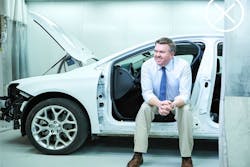WALKER’S COLLISION REPAIR
LOCATION: SEYMOUR, TENN.
SIZE: 15,000 SQUARE FEET
STAFF: 24
AVERAGE MONTHLY CAR COUNT: 150
ANNUAL REVENUE: $4 MILLION
LOCATION: KNOXVILLE, TENN.
SIZE: 50,000 SQUARE FEET
PROJECTED STAFF: 30
PROJECTED MONTHLY CAR COUNT: 300
PROJECTED ANNUAL REVENUE: $8 MILLION
On the collision side, there’s Paul Walker. He was born and raised in the business, starting with a 30-by-40-foot garage 27 years ago and growing to two shops—one, a 50,000-square-foot facility filled with the latest technology.
On the insurance side, there’s Wayne Griffin. He worked for Geico and Safeco for 30 years, training estimators on properly writing and documenting repairs and badgering shop owners about getting estimators the necessary training.
And despite any preconceived notions you may have about this relationship or the shop-insurer dynamic in general, just know one thing: Walker and Griffin both care deeply about the customer experience, and both are on the same team.
In fact, they’ve been on the same team for quite a few years, starting back when Griffin served as a quality assurance reinspector for Safeco, and continuing now through his recently appointed position as director of operations at Walker’s Collision Repair in Knoxville, Tenn., where he’s improving DRP relations by selling the shop’s customer service.
The move indicates Walker’s vision for the business: His dozen-or-so DRP relationships catapulted his tiny shop into two multi-million- dollar facilities, and, according to him, bringing an insurance insider into the mix sets his shop up for further growth.
THE COLLISION EXPERT
Walker thought he was on top of the world.
Looking back on it now, he laughs. But as a 15-year-old farmhand with little money and dreams of running his own company, being paid $800 to paint a neighbor’s car was his first official business transaction.
“I never looked back after that,” he says.
Hard-working and self-taught, Walker started what would one day become the two-location operation out of his grandfather’s barn. He trained himself on painting and repairs, and continued to work on vehicles as his business expanded: He opened his first 1,200-square-foot location in 1989, and established his first DRP relationship 15 years later when he expanded with a 5,000-square-foot facility.
Walker replaced his original location with a 15,000-square-foot building in 2010 (thanks to a dozen new DRP relationships, he says), and recently wrapped up construction on his 50,000-square-foot dream facility.
Despite his role as president of Walker’s Collision Repair, Walker has continued to keep up on his technical training, including recently becoming aluminum repair certified through I-CAR. He lives and breathes collision repair, and has made adding more DRP relationships the main focus for shop growth—and Griffin plays a huge part in that.
THE INSURANCE EXPERT
Like Walker, Griffin grew up in body shops. However, as opposed to sticking with the family business, where he was being groomed as an estimator, Griffin decided to take his customer service talents to the insurance side.
Starting with Geico in 1986 and moving to Safeco in 2000, Griffin has remained an “industry guy” throughout his career, joining the Nashville I-CAR Committee several years ago and hosting estimating training for Tennessee shops on proper customer service and estimate writing.
Griffin worked with Walker’s collision repair business for years, and as the two discussed the future of the industry, they each realized their combined talents could take Walker’s Collision Repair—which was primed to expand and add more DRP relationships—to the next level.
“We had lots of conversations about what I brought from the insurance side, and what they needed on the body shop side,” he says. “That was my goal when I came here, to make sure we’re being good partners with the insurance side, with photos, customer service, follow- ups, and repairs.”
THE INSIDE SCOOP
On the oft-contentious relationship between collision repair shops and insurance companies, Griffin’s philosophy has always been simple: “I think the most important thing for both sides to do first is realize that nobody is against each other,” Griffin says. “We’re not enemies—we have a common cause, which is the customer.”
Griffin and Walker have always gotten along as business partners and friends, and each understand they can help each other ensure success. And since Griffin knows the struggles on the insurance end, Walker’s Collision Repair can now offer solutions to those problems.
“A MAJOR DETRIMENT TO CSI SCORES IS NOT LAYING OUT THE REPAIR PROCESS PROPERLY, AND NOT FOLLOWING UP AFTERWARDS. WE MAKE SURE WE’RE COVERING BOTH ENDS.” –WAYNE GRIFFIN, DIRECTOR OF OPERATIONS, WALKER’S COLLISION REPAIR
“The insurance side is changing so much from the regular staff adjusters—now insurance companies handle half of estimates through DRPs,” he says. “That’s more than 50 percent of their job that they're not touching, that they’re not seeing.
“We have to do that for them. We are their eyes when we’re working with these customers.”
So when Griffin brainstorms methods of establishing more DRP relationships, he keeps one thing in mind: Insurance companies are another customer at your shop.
And just like with any customer, you have to sell yourself. Here’s how:
POLICIES AND PROCEDURES. The key, Griffin and Walker say, is not only properly documenting policies and procedures aimed at excellent customer service, but also advertising your ability to execute to insurance companies.
“A lot of the policies and procedures I’ve put in place are very insurance friendly,” Griffin says. “They’re the same policies and procedures [insurance companies] want, such as documentation, customer service, and moving cars along in the blueprinting line. The insurance companies all love it.”
DAMAGE REPORTS. When Griffin sells the shop’s capabilities and gives insurance companies a tour, he starts at the front counter.
“We share a common customer, so we started right with the beginning when we get an assignment from an insurance company,” he says. “We do a little more investigation, before we even make the first phone call.”
Before the initial call to the customer, Walker and Griffin expect the front counter staff to dig into the damage report to make the repair process more efficient and convenient down the line for both the customers and repair team. This includes:
- Determining if a car is drivable
- Setting up a rental vehicle (Enterprise has its own office in each Walker’s location)
- Planning a repair timeline to eliminate supplements
- Planning possible parts needed for the repair
THE INITIAL MEETING. After gathering that information, “customer service” means catering to the client’s schedule and making the initial face-to-face meeting convenient. “What if the customer isn’t ready that day? What if they’re busy? Do they need directions? Do they need us to text them a Google Map?” Griffin asks. “We try to start off by asking the customer what they need. When you approach them from that direction, you start a rapport from the front end, letting them know you care about them.”
Using the information gathered in the damage analysis stage, Walker’s can accurately guide the customer through the potential timeline.
“A major detriment to CSI scores is not laying out the repair process properly, and not following up afterwards,” says Griffin. “We make sure we’re covering both ends.”
THE ESTIMATE. Through his past observations of estimators-in-training, Griffin has been able to shape a perfect list of policies and procedures that cater to insurance during the estimating process. “The most common mistake estimators make is not documenting fully and correctly,” Griffin says. “Most experienced estimators know how to write an estimate. They know what’s needed to repair the vehicle. But sometimes it’s hard to get them to realize that with insurance companies, there are [many] people that don’t have that experience level, and they’re not standing in front of the car.”
That’s why documentation and photos are needed to provide information for any potential questions on the insurance end. Griffin and Walker require their estimators to explain certain decisions with notes and reasoning.
“I think it’s very important that we tell the whole story, and that’s what I tried to get across in my previous position: Don’t leave facts out,” Griffin says. “You’re not just repairing a fender—why are you repairing that fender versus replacing it? What are you seeing there? There’s lots of information that needs to be shared.”
CSI SCORES. Talking about your customer service skills is one thing, but producing results is another. Walker’s now conducts customer service surveys, reporting its CSI numbers to insurance companies through its CCC ONE management system.
“We have follow-up calls with customers after they pick up the car,” Griffin says. “Someone calls within 48 hours to ask about the customer service survey, and to make sure everything is OK with the car, to get those results. Insurance companies want to see those surveys.”
Oh, and the CSI scores they’re reporting to insurance companies? For both shops, the average is around 97 percent.
MOVING FORWARD
Labeling Walker’s Collision Repair as an “insurance-friendly institution” has always been the goal for Walker. By working with Griffin, he will continue to build those relationships—and set the shop up for success in the process.
“When you’ve got really nice facilities and equipment and technicians that know what they’re doing, that’s most important,” Griffin says. “But to show insurance companies that you are willing to work with them, that you have the technology to fix the cars correctly, that you’re putting policies and procedures into place that will help them and the customer, then they’re pretty willing to work for you. That’s the kind of shop they’re looking for.”

